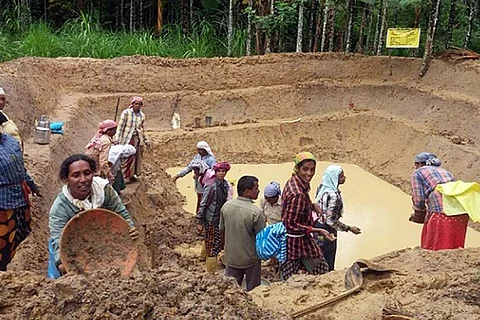

The Kerala floods were a watershed moment for the state and its people in every sense, some for the good and some for the worse. While it claimed several lives and destroyed properties, it also left several people looking for livelihood options. And post the floods, the Mahatma Gandhi National Rural Employment Guarantee Scheme came a boon to the people, especially women and the elderly. According to a MGNREGA report, Kerala generated more than 5 crore person days in the financial year 2018-2019, a significant jump from its target.
While the central government had sanctioned 550 lakh person days at the beginning of the financial year for Kerala, until July 2018, Kerala had not crossed 250 lakh person days. As on February 14, 2019, 16.14 lakh individuals benefited from the scheme. Out of this, after August 16, 2018, 11.09 lakh individuals were provided employment, of which 5.30 lakh individuals were newly employed after the flood.
Under NREGA, 100 days of wage employment is guaranteed to every household whose adult members can do unskilled manual work. Since this is a demand-driven scheme, people came forward for jobs after the floods, says Divya Iyer, Director of Employment Guarantee Mission in Kerala.
“After the floods in mid-August, a lot of people were deprived of their traditional employment opportunities, including farmers, small-scale farmers and people from lower economic strata of society. When the government announced ‘Rebuild Kerala’, livelihood rejuvenation was one of the pillars under the project for the affected population. We realised it was appropriate to use the scheme to introduce more jobs in the state when it was much needed,” recounts Divya.
The beneficiaries under the scheme helped restore farmlands, canals, streams, wells and rivers, in addition to common public assets such as school playgrounds, Anganwadis, mangroves and streetlights, all of which were rendered useless after the floods. “It was a win-win situation for the people who lost their livelihood and for the flood-ravaged state,” Divya said.
The wage rate in Kerala is Rs 271 per day, as fixed by the central government.
“In light of the floods, we had submitted a revised budget to the central government. From 550 lakh person days, it was increased to Rs 700 lakh person days. We crossed that also. We could generate more than 5.75 crore person days. As a result, Rs 1558.77 crore worth of employment was generated,” says Divya.
New job cards were also issued to 66,252 families after the flood. “Even the existing cardholders, who were inactive and irregular, started coming back. Around 5 lakh such people became active after the floods,” she adds.
The Kerala government enabled 100 extra days of wage employment for the Scheduled Tribe families. Additionally, the Centre granted 50 more days of employment for the badly affected seven districts in the state.
Women beneficiaries highest in Kerala
According to Divya, 80% beneficiaries under the scheme in Kerala are women, who have generated 90.48% person days. “This is the highest in the country,” she says.
While field officers say that the percentage of person days generated by women has always stood between 86% and 98% in the last few years, what has changed is their determination to be the breadwinner in the family.
N Vinodini, Joint Programme Coordinator, Alappuzha, says that women consider the scheme a boon, as it means they can manage their household chores as well as make a living. “Women are able to find a job within 5 km radius of their house. This is a big draw. Besides, the work hours have been reduced from 8 am-5 pm to 9 am-5 pm. This gives them time to go home, have lunch and get back to work, unlike other employed women,” she says.
From cleaning houses and wells to working at plantations, women beneficiaries between the age of 30 and 90 take up jobs under the scheme.
Shaji, JPC in Thiruvananthapuram, adds that the majority of women participants are Kudumbashree members. “The jobs under this scheme, especially natural resource management activities such as canal renovation or land development, are women-friendly. Besides, these jobs involve less physical exertion. That’s why among the male beneficiaries, most of them are elderly who cannot perform heavy-duty work,” he elucidates.